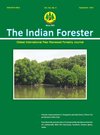Genome Size Estimation Using Flow Cytometry in Elettaria cardamomum Maton
DOI:
https://doi.org/10.36808/if/2016/v142i9/102545Keywords:
2C Nuclear DNA, Cardamom, Elettaria cardamomum, Flow Cytometry, Genome Size.Abstract
The relative 2C genome size and total number of base pairs of small cardamom (Elettaria cardamomum Maton) was determined using flow cytometer. Seven accessions of cardamom were included in the present study. Zea mays L. CE-777 (2C=5.43 pg) was found to be the most suitable reference standard. Samples for analysis were prepared following the two step procedure described by Otto and involving Propidium iodide staining. The fluorescence intensity of 5000 particles was recorded. The mean amount of 2C nuclear DNA of the cardamom sample was calculated as 2.84 pg. Conversion between DNA content and genome size (1 pg DNA=980 Mbp) indicate that the diploid genome size of cardamom is 2783 Mbp. This is the first report of DNA content and genome size in cardamom. Low variation in genome size has been observed for various germplasm accessions including wild, released varieties and landraces.References
Ashitha J.P., Anija T.A., Anjali N. and Sabu K.K. (2013). Genetic diversity among cardamom germplasm accessions assessed by SSR and ISSR analysis. Proceedings of the 25th Kerala Science Congress held at Technopark at Thiruvananthapuram during 29th January to 1st February 2013, pp. 263-265 (03-27).
Bennett M.D. and Leitch I.J. (2005). Plant genome size research - a field in focus. Annals of Botany, 95: 1–6.
Bures P., Tichy L., Wang Y. and Bartos J. (2003). Occurrence of Polypodium ×mantoniae and new localities for P. interjectum in the Czech Republic confirmed using flow cytometry. Preslia, Praha., 75: 293–310.
Dolezel J. and Bartos J. (2005). Plant DNA Flow Cytometry and Estimation of Nuclear Genome Size. Annals of Botany, 95: 99–110.
Dolezel J., Bartos J., Voglmayr H. and Greilhuber J. (2003). Nuclear DNA content and genome size of trout and human. Cytometry Part A., 51A: 127–128.
Dolezel J., Greilhuber J. and Suda J. (2007). Estimation of nuclear DNA content in plants using flow cytometry. Nature protocols,2: 2233-2243.
Galbraith D.W., Harkins K.R., Maddox J.M., Ayres N.M., Sharma D.P. and Firoozabady E. (1983) Rapid flow cytometric analysis of the cell cycle in intact plant tissues. Science, 220: 1049-1051.
George K.J., Varma R.S., Ganga G., Utpala P., Sasikumar B., Saji K.V., and Parthasarathy V. A. (2006). ISSR markers for genetic diversity analysis in spices - An appraisal. Indian J. Hort., 63(3): 302-304
Kumar N., Abdul Khader J.B.M. Md., Rangaswami P. and Irulappan (1997). Introduction to spices, plantation crops, medicinal and aromatic plants. Oxford and IBH publishing company Pvt Ltd, 2.12-2.22.
Kuriakose G., Sinu P. A. and Shivanna K.R. (2008). Domestication of cardamom (Elettaria cardamomum) in Western Ghats, India: divergence in productive traits and a shift in major pollinators. Annals of Botany, 103(5): 727-733.
Leong-Skornickova J., Sida O., Jarolimova V., Sabu M., Fer T., Travnicek P. and Suda J. (2007) Chromosome numbers and Genome size variation in Indian species of Curcuma (Zingiberaceae). Annals of Botany, 100: 505-526.
Loureiro J, Rodriguez E, Dolezel J & Santos C. (2006a) Comparison of Four Nuclear Isolation Buffers for Plant DNA Flow Cytometry. Annals of Botany, 98: 679–689.
Loureiro J., Rodriguez E., Dolezel J. and Santos C 2006b Flow Cytometric and Microscopic Analysis of the Effect of Tannic Acid on Plant Nuclei and Estimation of DNA Content. Annals of Botany, 98: 515–527.
Lysak M.A., Rostkova A., Dixon J.M., Rossi G. and Dolezel J. (2000). Limited Genome size variation in Sesleria albicans. Annals of Botany, 86: 399-403.
Palomino G., Dolezel J., Mendez I. and Rubluo A. (2003). Nuclear genome size analysis of Agave tequilanaWeber. Caryologia, 56: 37-46.
Pecinka A., Suchankova P., Lysak M.A., Travnicek B. and Dolezel J. (2006). Nuclear DNA content variation among Central European Koeleria taxa. Annals of Botany, 98: 117–122.
Prasath D. and Venugopal M.N. (2009a). Compound inflorescence cardamom (Elettaria cardamomum (L.) Maton) in India. Genetic Resources and Crop Evolution, 56: 749-753.
Prasath D., Venugopal M.N., Senthilkumar R. and Leela N.K. (2009b). Hybrid performance for yield and yield components in cardamom (Elettaria cardamomMaton). Euphytica, 168 (1): 49-60
Purseglove J.W., Brown E.G., Green C.L. and Robbins S.R.J. (1981). Spices. Longman, New York, USA.
Roux N., Toloza A., Radecki Z., Zapata-Arias F.J. and Dolezel J. (2003). Rapid detection of aneuploidy in Musa using flow cytometry. Plant Cell Rep., 21: 483-490.
Thomas E., Kizhakkayil J., Zachariah T.J., Syamkumar S. and Sasikumar B. (2006). Comparative quality characterization and molecular profiling of Indian, Sri Lankan and Guatemalan cardamoms. Journal of food, agriculture and environment, 4(2): 129-133
Venugopal M.N. (1999). Natural disease escapes as sources of resistance against cardamom mosaic virus causing katte disease of cardamom (Elettaria cardamomumMaton). J. Spices and Aromatic Crops, 8 (2): 145-151.
Downloads
Downloads
Published
How to Cite
Issue
Section
License
Unless otherwise stated, copyright or similar rights in all materials presented on the site, including graphical images, are owned by Indian Forester.





